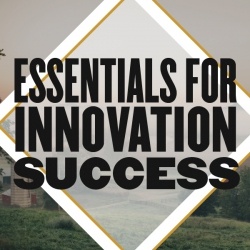 Article
Article
De Jong, Marc, N. Marston, E. Roth. (2015). “The Eight Essentials of Innovation.” Mckinsey Quarterly.
Reviewer
Dr. Allan Gray, Executive Director and Professor
Summary
The authors explore the elements that set successfully innovative companies apart from their less innovative counterparts. Their research consists of in-depth interviews, workshops, and surveys of 2500 executives at over 300 companies. The research defined success as a weighted index of measures for organic growth (percent of growth from new products/services developed in-house) and innovation performance (percent of sales from new products and self-assessments of innovation performance). From the research, they identified eight essential elements of innovation success: Aspire, Choose, Discover, Evolve, Accelerate, Scale, Extend, and Mobilize. The authors note that there is no proven formula for innovation success but argue that there is a strong correlation between these essential elements and success. A firm that strives to apply these essentials to their unique situation can improve their probability of sparking innovation within the company.
What this means for food and agribusinesses
In the last quarterly review, I reviewed an article about creating strategic clarity. One of the keys to clarity was having an innovation strategy. I said in that article:
“Certainly, in the market we face in food and agriculture today the innovators are the ones reshaping the industry from the digital farming innovators, to the niche market creators in the food industry. Those of us more inclined to want to stick to the “tried and true” are increasingly at risk of looking up and finding that we have been innovated out of our own industry.”
In particular, it seems that the wave of mergers and acquisitions we have in agriculture and food today is indicative of an industry struggling to find organic growth in a commodity market. For established firms this is a dangerous time. Established firms often struggle to think outside the box and have become accustomed to winning through better execution and business optimization. There is certainly nothing wrong with striving for better execution. However, we must be careful not to ignore potential disruptive innovations that could make us obsolete. This research article provides us a good framework for thinking about how we can make innovation a crucial part of our business culture.
The first four essentials in the authors’ innovation operating system identify the business conditions where innovation is more likely to thrive:
- Aspire – The company will have a clear innovation vision, require growth contributions directly from innovation, and have clear cascading targets and accountabilities across the firm related to innovation.
- Choose – The company will have clearly articulated innovation themes that result in a portfolio of innovation projects that balance timeframe and risk profile with sufficient funding and governance to allow strong ideas to win.
- Discover – The company’s new ideas will come from having a core focus on customers, involve multiple people with varying insights, and be keen on identifying a differentiated value proposition from competitors.
- Evolve – The company will embrace changes in business models, value-chain dimensions, diversified profit streams and customer groups.
In food and agribusiness, one clear trend in innovation is the digitization of the industry and the potential it has to redefine business models and value chain partners. There are multiple avenues being pursued in this space on the food end of the value chain and the agricultural input part of the chain. How is your firm looking at these innovations and how it may affect your firm’s place in the value chain in the future. Are there opportunities for you to set the expectations for your company that will allow decision-makers to explore alternative business models and partnerships in this space? Do you have a team dedicated to thinking about new ways to innovate your products, services, or processes to address this changing environment?
The last four essentials in the authors’ innovation operating system identify the mechanisms for delivering and organizing innovation to become an engine that contributes value consistently over time.
- Accelerate – The company will consistently beat the competition to innovation by having rigorous planning and execution with cross-functional projects focused on both customer and market-based learning.
- Scale – The company will be able to launch innovation at the right scale for the relevant markets and segments by having a clear go-to-market strategy that manages the launch and understands the operations ramp-up.
- Extend – The company will enhance innovation success by embracing strategic external networks. This will require the company to have keen collaboration skills and be recognized as a partner of choice for other firms in the value chain looking to innovate.
- Mobilize – The company will organize its people, processes, and culture to create a learning and adaptive organization where people are clearly motivated and rewarded to innovate repeatedly.
The clear message here is that for an organization to enhance its innovation success, it has to be intentional about the people, processes, and culture it puts in place. Much of the food and agribusiness industry, its seems to me, is structured to focus on efficiency and operations. Shifting the mentality and culture of our organizations to win in the marketplace through innovation is not an easy task. The industry is built on consistency, tradition and relationships. We want to be careful when we try new things not to “mess up” those elements of our past success. Nevertheless, we should also be quick to recognize that the history of food and agriculture has been one of innovations—some of which have profoundly changed the industry, leaving some companies behind in the process. As our industry searches for the next disruptive value creator, we would be wise to take heed of the eight essentials this research has identified and look for ways to incorporate them into our companies to allow us a better chance to be a participant in that next wave of value creation.




